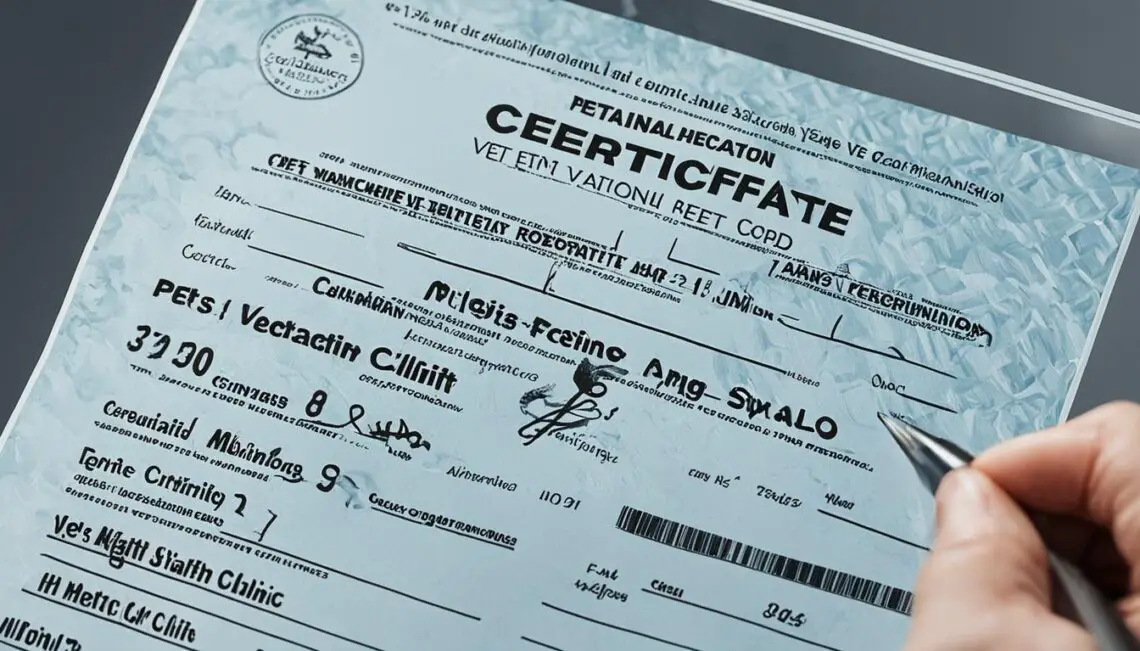If you’re a pet owner with small animals and you’re planning on traveling, there are a few things you need to consider to ensure a smooth and enjoyable journey. Traveling with pets requires some extra planning and preparation to keep them safe, happy, and comfortable throughout the trip. In this article, I will share some essential travel tips specifically designed for small animal owners. From consulting with your vet to packing enough food and water, these tips will help make your travel experience stress-free and fun for both you and your furry friend.
Key Takeaways:
- Consult with your veterinarian before traveling to assess your pet’s health and determine any necessary vaccinations or health certificates.
- Pack ample food and water to ensure your pet’s dietary needs are met throughout the trip.
- Practice long-distance travel with your pet beforehand to gauge their behavior and address any potential issues.
- Use restraints such as carriers or safety restraint systems to ensure your pet’s safety during the journey.
- Enjoy your trip and create unforgettable memories with your small animal companion!
Check with Your Vet Before Traveling
Before embarking on a trip with your small animal, it is important to consult with your veterinarian. They can assess your pet’s health and determine if they are fit for travel. Some pets may require additional vaccinations or health certificates depending on the destination. Your vet can provide guidance on any necessary steps to take before traveling.
When planning a trip with your small animal, it’s crucial to prioritize their health and well-being. Consulting with your vet beforehand will ensure that your pet is in optimal condition to travel and that all necessary precautions are taken.
- Book an appointment with your vet well in advance of your travel date.
- Inform your vet about your travel plans, including the destination and duration of the trip.
- Ask your vet if your pet requires any specific vaccinations or health certificates for the destination. Different locations may have different requirements, so it’s important to be informed.
- If your pet has any pre-existing health conditions, discuss with your vet how to manage them during the journey.
In my experience, consulting with a vet before traveling has been invaluable. Not only did it give me peace of mind knowing that my pet was healthy and fit to travel, but it also allowed me to take necessary precautions to ensure a smooth journey for both of us.
By consulting with your vet before traveling, you can address any potential health concerns and make informed decisions regarding your small animal’s travel arrangements. Remember, their well-being is a top priority.
Sample Vaccinations and Health Certificates
| Vaccination/Health Certificate | Description |
|---|---|
| Rabies Vaccination | A vaccination required by many destinations to prevent the transmission of rabies. It typically needs to be administered within a specific timeframe before travel. |
| Health Certificate | A document signed by a veterinarian certifying that your pet is healthy and fit to travel. Some destinations may require this certificate to ensure your pet is free from infectious diseases. |
| Additional Vaccinations | Depending on your destination, additional vaccinations such as distemper, parvovirus, or bordetella may be recommended or required to protect your pet from specific diseases. |
Pack Ample Food and Water
When traveling with small animals, it is important to pack enough food and water to ensure their well-being throughout the entire trip. Not all locations may have the specific food your pet needs, so bringing an ample supply is crucial.
Make sure to pack your pet’s favorite brand and type of food, as sudden changes in diet can cause digestive issues and discomfort. It’s a good idea to pack extra food in case of any unexpected delays or changes in plans.
To keep your pet hydrated, pack enough water for the duration of the journey. Refillable water bottles or containers are practical options to ensure a continuous supply of fresh water. Additionally, having a collapsible water bowl will make it easier to serve water to your pet on the go.
Remember to regularly offer food and water to your small animal during breaks in the journey. Being well-nourished and hydrated will help keep them comfortable and reduce any travel-related stress.
To help you pack the right amount of food and water for your pet, consider their size, dietary needs, and the duration of the trip. Consulting with your veterinarian can provide further guidance on the appropriate quantities to bring.
By properly packing ample food and water for your small animal, you can ensure their well-being and comfort throughout the travel experience.
Practice Long-Distance Travel
For small animals that are not accustomed to long car rides, it is important to practice before embarking on an actual trip. Taking your pet on longer rides than usual allows you to observe their behavior and prepare for the journey ahead.
During these practice runs, pay attention to how your pet reacts to being in the car for an extended period. Some pets may experience motion sickness or become anxious during travel, so it is crucial to be aware of these potential challenges.
“Practicing long-distance travel helps familiarize your pet with extended car rides and allows you to address any issues or concerns before your actual trip.”
By gradually increasing the duration of these practice runs, you can help your small animal become more comfortable and relaxed during long-distance travel. This practice also provides an opportunity for you to identify any necessary adjustments or accommodations to make their journey more enjoyable.
Remember to ensure that your pet is secure and comfortable in their carrier or restraint system during these practice runs. This will help them become accustomed to their travel arrangements and minimize any potential stress or discomfort.
In preparation for your long-distance trip, consider packing familiar items such as their favorite toys or blankets to provide a sense of comfort and familiarity. This can help reduce any anxiety your pet may experience during travel.
Practicing long-distance travel with your small animal can help alleviate their travel-related stress and ensure a smoother journey for both of you. Use these practice runs as an opportunity to gauge your pet’s comfort level and address any concerns before embarking on the actual trip.
Ensure Restraints for Safety
When traveling with small animals, their safety should be a top priority. Using restraints not only protects your pet but also ensures your own safety during the journey. Here are some guidelines on how to properly restrain your small animal:
Cats:
- Cats should travel in secure carriers that are either secured to the seat or placed on the floor.
- Make sure the carrier is well-ventilated and has a sturdy latch to prevent any accidental openings.
- Place a comfortable blanket or bedding inside the carrier to keep your cat cozy.
- Ensure that the carrier is properly sized for your cat, allowing them to stand, lie down, and turn around comfortably.
Dogs:
- Dogs can travel in carriers or use special safety restraint systems designed for this purpose.
- If using a carrier, follow the same guidelines as mentioned for cats.
- If using a safety restraint system, choose one that is specifically designed for your dog’s size and breed.
- Make sure the restraint system is properly secured to the seat or anchored to the car’s interior.
These restraints are crucial in ensuring that your pet remains secure throughout the journey, minimizing the risk of injury. Remember to always follow the manufacturer’s instructions for proper installation and usage. It is also advisable to gradually introduce your pet to the restraint system before the trip to minimize any anxiety or discomfort.
By implementing these safety measures, you can have peace of mind knowing that your small animal is protected during travel, allowing you to focus on enjoying the journey together.
Conclusion
Traveling with small animals can be a rewarding experience, allowing you and your furry friend to bond over new adventures.
By following these travel tips, you can ensure a safe and comfortable journey for your pet. Remember to consult with your vet before traveling to ensure that your pet is healthy and fit for the trip. They can provide guidance on vaccinations or health certificates that may be necessary for your specific destination.
Packing ample food and water is crucial for your pet’s well-being. Make sure to bring enough of their regular food, as it may be difficult to find specific brands or types while on the road. Don’t forget to pack refillable containers and bowls for serving during the journey.
To prepare your small animal for long-distance travel, practice taking them on longer car rides before the actual trip. This will help them adjust to the environment and minimize the chances of motion sickness. It’s always better to be prepared than to deal with unexpected discomfort during the journey.
Lastly, ensure the safety of your pet by using restraints during travel. Cats should travel in secure carriers that are either fastened to the seat or placed on the floor, while dogs can use special safety restraint systems or carriers. These restraints will prevent your pet from wandering or getting injured during the trip.
Enjoy your trip with your small animal companion and create unforgettable memories together. Traveling with pets can be a unique and enriching experience, allowing you both to explore new places and strengthen your bond. With proper planning and care, you can make your journey enjoyable and stress-free for your furry friend.
FAQ
Do I need to consult with my vet before traveling with my small animal?
Yes, it is important to consult with your veterinarian before embarking on a trip with your small animal. They can assess your pet’s health and determine if they are fit for travel. Your vet can provide guidance on any necessary steps to take before traveling, such as additional vaccinations or health certificates.
How much food and water should I pack for my small animal?
It is essential to pack enough food and water for your pet’s entire trip. Not all locations may have the specific food your small animal needs, so bringing an ample supply is crucial. Remember to pack refillable containers for water and food, as well as bowls for serving on the road.
Should I practice long-distance travel with my small animal before the actual trip?
Yes, for small animals that are not accustomed to long car rides, it is a good idea to do some practice runs before the actual trip. Take your pet on longer rides than usual and observe their behavior. This will give you an idea of how they will react during the actual journey. It’s important to note that some pets may experience motion sickness, so it’s crucial to be aware of this before embarking on a long journey.
How can I ensure the safety of my small animal during travel?
When traveling with small animals, it’s important to use restraints for their safety and yours. Cats should travel in secure carriers that are either secured to the seat or placed on the floor. Dogs can travel in carriers or use special safety restraint systems designed for this purpose. These restraints ensure that your pet remains secure during the journey, minimizing the risk of injury.






No Comments